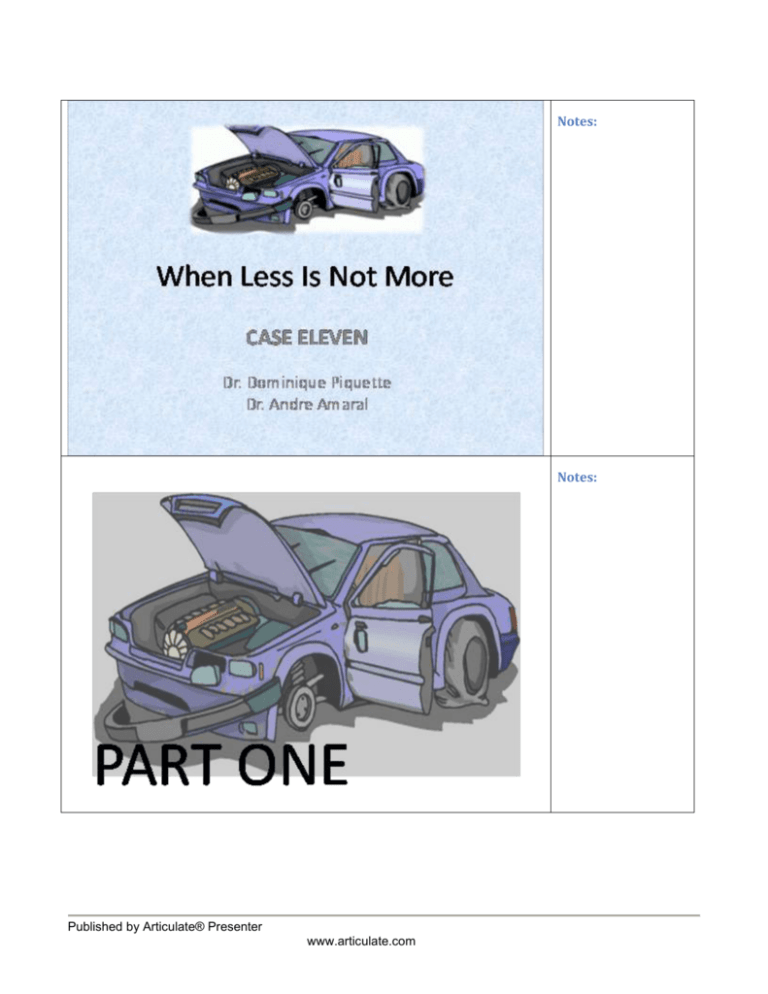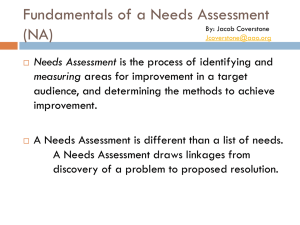Notes: Notes: Notes: Notes: Notes: Notes: Notes: Notes: Notes
advertisement

Notes: Notes: Published by Articulate® Presenter www.articulate.com Notes: It’s Wednesday night and you are on call for the ICU. Around 2:00 AM, you are called to the unit to admit a new trauma patient who just arrived from the OR. You have vaguely heard about this case earlier in the evening from the charge nurse: “An intubated patient was urgently transferred from the E.R. to the O.R. in pretty bad shape". You haven't talked to the Trauma Team Leader or to any surgical team involved yet, but the nurse is currently more concerned with the systolic BP at 70 than with providing you with a detailed history. Notes: You order a liter of fluid and take a look at the Trauma Team Leader’s note, but the information available is limited. This patient was the unfortunate passenger of a car that was hit on the highway by a beam dropped from a truck. The beam caused a huge dent in the passenger door. Not surprisingly, the driver of the car then lost control of the vehicle, which eventually ended up in a ditch. Published by Articulate® Presenter www.articulate.com Notes: Based on the chart, the 58-year-old patient was found unconscious on scene and was intubated in the Emergency Room for airway protection. His initial BP was in the low 60’s and he received two liters of NS by EMS. On arrival in the E.R., the patient received another 2L of crystalloids for ongoing low BP and eventually 2 units of PRBC. Notes: A first chest tube was inserted on the right side for decreased air entry and immediately drained 1.2L of blood. The drain was clamped, but the patient transiently arrested. The surgeon proceeded with an urgent right thoracotomy, clamped some vessels, and rushed the patient to the OR. Published by Articulate® Presenter www.articulate.com The right main pulmonary artery was injured and at the end, the surgeon had to proceed with a right pneumonectomy. The patient's hemodynamic status during the surgery appears to have presented certain challenges for the anesthetist! Mr. Viscount received overall 3 liters of crystalloids and 5 units of PRBC. A pool of platelets was also administered. At the end of the case, an infusion of norepinephrine was started and is still running at 12mcg/min on arrival to the ICU. A bolus of 1U of vasopressin was also given in the latest part of the surgery. Notes: Notes: In terms of injuries, the patient also had an open right tibial fracture that couldn't be fixed during the OR because of ongoing instability. A FAST completed in the E.R. and repeated in the OR didn't reveal significant amount of free fluid in the abdomen. And that's about what you can find quickly in the chart. Published by Articulate® Presenter www.articulate.com Notes: The BP has only responded subtly to your bolus of fluid. You ask the RN to bring the Level 1 and order another liter of RL. You make sure that blood is available if needed. You complete a physical examination. The patient’s brainstem reflexes are normal and he is flexing to central and peripheral pain. In fact, the RN saw him move spontaneously his left arm and gave him 25ug of fentanyl. He is in a hard collar. His chest sounds a bit crackly on the left and quite horrible on the right. There are 2 chest tubes on the right side, both draining some sero-sanguineous fluid in reasonable amount. The abdomen is soft. The dressing on the right leg looks fairly dry. The urine output has been about 20cc in the last hour. The patient’s most recent vitals are: You check in the computer for the most recent blood work, but the results from the blood drawn in the ICU are not back yet. Published by Articulate® Presenter www.articulate.com Notes: The surgeon walks in the ICU to check on his patient. When he learns about the 2 liters of fluids given, he looks extremely upset. Notes: “Are you trying to kill my patient?? I’m worried that the left lung will get flooded with fluids and that the patient will develop a full-blown ARDS.” Personally, I am more worried about the overall perfusion of the patient... Notes: The atmosphere is getting a bit tense... The RN announces that the blood work is back (a welcome distraction!)… Published by Articulate® Presenter www.articulate.com Notes: Blood Gas Type pH pCO2 pO2 Bicarbonate Saturation FiO2 ARTERIAL 7.27 49 220 20 0.98 1.0 7.35 - 7.45 35 - 45 mm Hg 80 - 100 mm Hg 21 - 28 mmol/L 0.90 - 1.00 CBC Hemoglobin WBC Count Neutrophils Lymphocytes Monocytes Eosinophils Basophils Platelet Count Hematocrit 88 16.8 15.3 3 0.6 0 0.1 167 0.395 115 - 165 g/L 4.0 - 11.0 x 10E9/L 2.0 - 7.5 x 10E9/L 1.0 - 4.0 x 10E9/L 0 - 1.0 x 10E9/L 0 - 0.7 x 10E9/L 0 x 0.3 x 10E9/L 150 - 400 x 10E9/L 0.340 - 0.490 L/L 1.7 0.71 0.92 31 2.20 - 2.60 mmol/L 0.70 - 1.05 mmol/L 0.87 - 1.52 mmol/L 35 - 50 g/L Electrolytes Sodium Potassium Chloride CO2 Total 149 3.1 117 19 135 - 147 mmol/L 3.5 - 5.0 mmol/L 95 - 107 mmol/L 22 - 30 mmol/L Glucose- Random 8.9 4.0 - 8.0 mmol/L INR PTT 1.59 33.0 0.9 - 1.10 INR 24.0 - 34.0 SECS Renal Profile Urea Creatinine 9.5 119 3.0 - 7.0 mmol/L 44 - 106 umol/L 985 4 <0.01 0.28 < 195 IU/L 2- 6 ng/mL < 0.05 < 0.10 ug/L 6.4 0.5 - 2.0 mmol/L Calcium Magnesium Phosphate Albumin CK + CK-MB CK mB Mass mB Mass Fraction Troponin T Lactate - Serum Published by Articulate® Presenter www.articulate.com Notes: Notes: You check the chest x-ray and notice mild left diffuse patchy infiltrates and a small right pleural effusion. The ECG shows diffuse T waves inversion. The surgeon is watching your next move… Notes: Objectives -To understand the physiological changes associated with a traumatic pneumonectomy. -To adequately investigate and manage a shock associated with a polytrauma. Questions: - Why do you think the surgeon is upset? - How would you justify the management so far? PROPERTIES Allow user to leave interaction: Show ‘Next Slide’ Button: Completion Button Label: - What is the etiology of the low BP? - Would you request any further investigations at this point? Anytime Show upon completion Next Slide - What are the expected complications posttraumatic pneumonectomy? Published by Articulate® Presenter www.articulate.com - How is that different than for an elective pneumonectomy? Notes: Published by Articulate® Presenter www.articulate.com Notes: You decide to start an infusion of vasopressin to address temporarily the hypotension. You then order a repeated echocardiogram to rule out any cardiac contusions/dysfunction and to assess the right ventricle. You will need some arguments to convince the surgeon that this patient needs more fluids. You're not even so sure anymore that it's the case... Notes: Published by Articulate® Presenter www.articulate.com Notes: You are pretty happy about the oxygenation for now and you're not sure that the CO2 is a big deal... The echo technician gives you a report: the left ventricular function is normal, the right ventricle is moderately depressed without dilatation, there is only a trace of pericardial effusion, and there is a moderate tricuspid regurgitation. Notes: You review the final report of the CT scans done, looking for other significant injuries. The BP is now 92/55. You are breathing a bit better, but the nurse is not. She had to increase the levo at 15mcg/min and to start the vasopressin at 2U/h to get that BP. She asks you if you want to give more fluids: "The patient is in atrial fibrillation now and the HR is up to 140." You notice that the CVP is 14. The surgeon had to go to the E.R. to assess another patient... Published by Articulate® Presenter www.articulate.com Notes: Objectives -To discuss the challenges of mechanical ventilation after a pneumonectomy. -To assess the fluid status of hemodynamically unstable trauma patients. -To discuss the physiological consequences and management of hypercapnia. PROPERTIES Allow user to leave interaction: Show ‘Next Slide’ Button: Completion Button Label: Questions: - Are you reassured by the echo results? - Do they affect your management at this point? Anytime Show upon completion Next Slide - How do you apply lung protective ventilation during single-lung ventilation? - Any concern about the use of PEEP for this patient? Published by Articulate® Presenter www.articulate.com Notes: Notes: Two weeks later, you are on call for the ICU. You learn that Mr. Viscount is still there. He did surprisingly well during the first few days after his initial surgery. However, his multiple rib fractures and flail chest have complicated the weaning process. He failed an extubation yesterday and is now scheduled for a tracheostomy. According to the daytime team, the reasons for his failure appeared to be a mix of bad lung mechanics, poor secretion management, and delirium. Published by Articulate® Presenter www.articulate.com Notes: Around 3:00am, you are called at the bedside of Mr. Viscount. The nurse has noticed some subcutaneous emphysema when she repositioned the patient. She asked for a chest x-ray that is now available. You compare the image to the one completed after the initial surgery: Notes: Questions: - Which findings would you expect on a CXR immediately after a pneumonectomy? - How do you interpret the second CXR? PROPERTIES Allow user to leave interaction: Show ‘Next Slide’ Button: Completion Button Label: Anytime Show upon completion Next Slide Published by Articulate® Presenter www.articulate.com Notes: The patient condition is overall stable. His ventilatory settings (PS 14, PEEP 8, FiO2 50%) haven't changed since his re-intubation. The amount of secretions is moderate. A sample was sent yesterday for culture. You have a new consultation to review in the Emergency Room so you ask the nurse to let you know if anything changes. Hopefully, nothing will until the end of your call... Notes: Objectives -To discuss the management of bronchopleural fistula, including adjustments of mechanical ventilation. -To recognize the indications for diagnostic and therapeutic drainage of pleural effusions. -To understand the role of thoracic surgery in the management of empyema. PROPERTIES Allow user to leave interaction: Show ‘Next Slide’ Button: Completion Button Label: Questions: - What do you think is happening? - Why would the patient deteriorate further? Anytime Show upon completion Next Slide Which investigations should be done? - Which factors will impact on the immediate and definitive management? Published by Articulate® Presenter www.articulate.com Notes: References Keel, M., Meier, C. Chest injuries – what is new? Curr Opin Crit Care. 13, 674-679 (2007). Ricardo, A., Itamar, A., Kounavsky, G.,Kessel, B. Total pulmonectomy in trauma: a still unresolved problem--our experience and review of the literature. Am Surgeon. 73 (4), 381-384 (2007). Jackson, T.A., Mehran, R.J., Thakar, D., Riedel, B., Nunnally, M.E., Slinger, P. Postoperative Complications After Pneumonectomy. J Cardiothor Vasc An. 21 (5), 743-751 (2007). RCPSC Objectives 6.1. RespiratoryDysfunction 6.1.1. The ability to determine the presence of respiratory failure, provide for its emergency support, and have a plan of action to subsequently investigate and manage problems. 6.1.2. Demonstrate knowledge of: 6.1.2.1. normal anatomy of the respiratory system 6.1.2.2. physiology of the gas exchange unit, lung and chest wall mechanics, airway dynamics 6.1.2.3. chest imaging of the ICU patient 6.1.2.4. the control of respiration 6.1.2.5. pathophysiology of disease states leading to respiratory failure 6.1.2.6. principles and theory of mechanical ventilation and other methods of respiratory support 6.1.2.7. respiratory problems and their management following surgical interventions Published by Articulate® Presenter www.articulate.com






